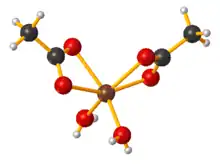Zinc acetate
Zinc acetate is a salt with the formula Zn(CH3CO2)2, which commonly occurs as the dihydrate Zn(CH3CO2)2·2H2O. Both the hydrate and the anhydrous forms are colorless solids that are used as dietary supplements. When used as a food additive, it has the E number E650.
 | |
 | |
| Names | |
|---|---|
| IUPAC name
Zinc acetate | |
| Other names
Acetic acid, Zinc salt Acetic acid, Zinc(II) salt Dicarbomethoxyzinc Zinc diacetate | |
| Identifiers | |
3D model (JSmol) |
|
| ChEBI | |
| ChEMBL | |
| ChemSpider | |
| ECHA InfoCard | 100.008.338 |
| EC Number |
|
| E number | E650 (flavour enhancer) |
PubChem CID |
|
| RTECS number |
|
| UNII |
|
| UN number | 3077 |
CompTox Dashboard (EPA) |
|
| |
| |
| Properties | |
| Zn(CH3COO)2(H2O)2 (dihydrate) | |
| Molar mass | 219.50 g/mol (dihydrate) 183.48 g/mol (anhydrous) |
| Appearance | White solid (all forms) |
| Density | 1.735 g/cm3 (dihydrate) |
| Melting point | Decomposes at 237 °C (459 °F; 510 K) (dihydrate loses water at 100 °C) |
| Boiling point | decomposes |
| 43 g/100 mL (20 °C, dihydrate) | |
| Solubility | 1.5 g/100 mL (methanol) |
| −101.0·10−6 cm3/mol (+2 H2O) | |
| Structure | |
| octahedral (dihydrate) | |
| tetrahedral | |
| Pharmacology | |
| A16AX05 (WHO) | |
| Hazards | |
| GHS labelling: | |
   | |
| Danger | |
| H302, H318, H319, H410, H411 | |
| P264, P270, P273, P280, P301+P312, P305+P351+P338, P310, P330, P337+P313, P391, P501 | |
| Related compounds | |
Other anions |
Zinc chloride |
Other cations |
Copper(II) acetate |
Related compounds |
Basic beryllium acetate |
Except where otherwise noted, data are given for materials in their standard state (at 25 °C [77 °F], 100 kPa).
Infobox references | |
Uses
Zinc acetate is a component of some medicines, e.g., lozenges for treating the common cold.[1] Zinc acetate can also be used as a dietary supplement.[2] As an oral daily supplement it is used to inhibit the body's absorption of copper as part of the treatment for Wilson's disease.[3] Zinc acetate is also sold as an astringent in the form of an ointment, a topical lotion, or combined with an antibiotic such as erythromycin for the topical treatment of acne.[4] It is commonly sold as a topical anti-itch ointment.
Zinc acetate is used as the catalyst for the industrial production of vinyl acetate from acetylene: CH3CO2H + C2H2 → CH3CO2CH=CH2 Approximately 1/3 of the worlds production uses this route, which because it is environmentally messy, is mainly practiced in countries with relaxed environmental regulations such as China.[5]
Preparation
Zinc acetates are prepared by the action of acetic acid on zinc carbonate or zinc metal. Treatment of zinc nitrate with acetic anhydride is an alternative route.[6]
Structures
In anhydrous zinc acetate the zinc is coordinated to four oxygen atoms to give a tetrahedral environment, these tetrahedral polyhedra are then interconnected by acetate ligands to give a range of polymeric structures.[7][8][9]
In the dihydrate, zinc is octahedral, wherein both acetate groups are bidentate.[10][11]
Reactions
Heating Zn(CH3CO2)2 in a vacuum results in a loss of acetic anhydride, leaving a residue of "basic zinc acetate," with the formula Zn4O(CH3CO2)6. It can also be prepared by a reaction of glacial acetic acid with zinc oxide.[12] The cluster compound has a tetrahedral structure with an oxide ligand at its center[13] Basic zinc acetate is a common precursor to metal-organic frameworks (MOFs).
See also
- Basic beryllium acetate - isostructural with basic zinc acetate
References
- "Zinc – Fact Sheet for Health Professionals". Office of Dietary Supplements, US National Institutes of Health. February 11, 2016. Retrieved November 15, 2018.
- Wegmüller, Rita; Tay, Fabian; Zeder, Christophe; Brnić, Marica; Hurrell, Richard F. (2014). "Zinc Absorption by Young Adults from Supplemental Zinc Citrate is Comparable with That from Zinc Gluconate and Higher than from Zinc Oxide". The Journal of Nutrition. 144 (2): 132–136. doi:10.3945/jn.113.181487. PMC 3901420. PMID 24259556.
- "Wilson Disease". NIDDK. July 2014. Archived from the original on 2016-10-04. Retrieved November 15, 2018.
- Schachner, L.; Eaglstein, W.; Kittles, C.; Mertz, P. (1990). "Topical erythromycin and zinc therapy for acne". Journal of the American Academy of Dermatology. 22 (2 Pt 1): 253–60. doi:10.1016/0190-9622(90)70034-f. PMID 2138176.
- Bienewald, Frank; Leibold, Edgar; Tužina, Pavel; Roscher, Günter (2019). "Vinyl Esters". Ullmann's Encyclopedia of Industrial Chemistry. Weinheim: Wiley-VCH. pp. 1–16. doi:10.1002/14356007.a27_419.pub2.
- O. F. Wagenknecht; R. Juza (1963). "Zinc Acetate". In G. Brauer (ed.). Handbook of Preparative Inorganic Chemistry, 2nd Ed. Vol. 2pages=1087. NY,NY: Academic Press.
- Clegg, W.; Little, I. R.; Straughan, B. P. (15 December 1986). "Monoclinic anhydrous zinc(II) acetate". Acta Crystallographica Section C. 42 (12): 1701–1703. doi:10.1107/S010827018609087X.
- He, Hongshan (15 November 2006). "A new monoclinic polymorph of anhydrous zinc acetate". Acta Crystallographica Section E. 62 (12): m3291–m3292. doi:10.1107/S1600536806046678.
- Capilla, A. V.; Aranda, R. A. (1979). "Anhydrous Zinc(II) Acetate (CH3-COO)2Zn". Crystal Structure Communications. 8: 795–797.
- van Niekerk, J. N.; Schoening, F. R. L.; Talbot, J. H. (10 September 1953). "The crystal structure of zinc acetate dihydrate, Zn(CH3COO)2.2H2O". Acta Crystallographica. 6 (8): 720–723. doi:10.1107/S0365110X53002015.
- Ishioka, T.; Murata, A.; Kitagawa, Y.; Nakamura, K. T. (15 August 1997). "Zinc(II) Acetate Dihydrate". Acta Crystallographica Section C. 53 (8): 1029–1031. doi:10.1107/S0108270197004484.
- Poshkus, Algirdas C. (June 1983). "Improved synthesis of basic zinc acetate, hexakis(.mu.-acetato)-.mu.-oxotetrazinc". Industrial & Engineering Chemistry Product Research and Development. 22 (2): 380–381. doi:10.1021/i300010a041.
- Koyama, H.; Saito, Y. (1954). "The Crystal Structure of Zinc Oxyacetate, Zn4O(CH3COO)6". Bull. Chem. Soc. Jpn. 27 (2): 112–114. doi:10.1246/bcsj.27.112.
